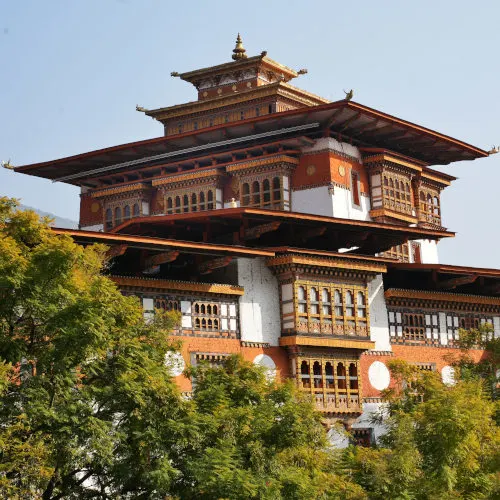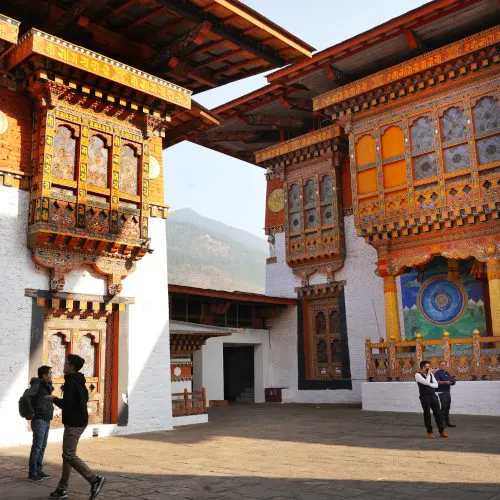
We made a day trip to visit Punakha Dzong and Chimi Lhakhang from Thimphu during our visit to Bhutan. These are the two historical places no one should miss while coming to Punakha. We will focus on our visit to Punakha Dzong in this article. You can read about our visit to Chimi Lhakhang here.

Punakha Dzong is also known as the Pungthang Dechen Phodrang, which means "palace of great happiness or bliss.” It is a Buddhist monastery and fortress in the Punakha Valley. We took our bus from Thimphu via the Dochula Pass to reach here, which took about two hours.

Punakha Dzong is situated across the confluence of the Pho Chhu and Mo Chhu rivers. After we arrived, our visit to Punakha Dzong started with a short walk across the Bazam Bridge to the main entrance of Punakha Dzong.

Don't miss the video shot at Punakha Dzong. It is at the end of this article. 👇👇
The magnificent courtyards
After crossing the bridge, we entered the Dzong through a heavy wooden door, which led to a wooden stairway and eventually took us to the outer courtyard.

Punakha Dzong is the most beautiful dzong we have visited in Bhutan. It is also the second largest dzong (and second oldest dzong) in Bhutan. It is renowned for its majestic structures, including four impressive gateways, seventeen temples, and stunning courtyards.

This incredible fortress also features beautiful ribbons of glazed terracotta tiles that run across the walls and roofs. Like many ancient Bhutanese buildings, Punakha Dzong was built without the use of nails. Instead, the structure was held together by interlocking stones and wooden beams.

The Punakha Dzong is unique as it has three courtyards instead of the typical two.


The outer courtyard (first courtyard) serves as the administrative center, featuring a large white Victory Chorten and a bodhi tree.

The middle courtyard is reserved for monastic quarters. It is where the monks' main temple and living quarters are.

The main temple has gold statues of the Buddha and Guru Rinpoche.

The inner courtyard is where the sacred remains of Ngawang Namgyal and the terton Pema Lingpa are kept. (See note at the end of the article). This courtyard was the favorite place and was reserved for Zhabdrung Rinpoche. He use to recide here in Punakha Dzong.
The south end of the courtyard boasts the kunrey, an enormous assembly hall of monks with 54 pillars. The intricate gold, red and black carvings throughout the dzong add to its artistic charm despite its grand scale.
Booking.comThe carvings and the exceptional murals
Punakha Dzong has a majestic six-storied central tower (Utse). From the massive central tower to the intricate paintings and murals, the dzong is a testament to the talent and skills of Bhutanese artists.

Its walls are embellished with intricate carvings and paintings. These murals depict various scenes from Bhutanese history and folklore, as well as from the life of Guru Rinpoche.



The History of Punakha Dzong
Punakha Dzong has a rich history that dates back to the 17th century. It was built by Ngawang Namgyal in 1637-1638 and served as the administrative center of the Punakha District. He is the person who united Bhutan and established it as a country.

In the 19th century, it also served as the winter residence of the Dratshang (the monastic body). Punakha is Bhutan's winter capital, and the head of the Bhutanese clergy and his entourage of monks reside in the Dzong during the winter.

In 2011, Punakha Dzong was the site of the royal wedding of Jigme Khesar Namgyel Wangchuck, the current King of Bhutan, to Jetsun Pema. The dzong also holds many important events, including the first National Assembly of Bhutan.

It is also the place for the coronation of the king. The first king was enthroned over here on 17.12.1907. Subsequently, all the coronations were also held here. Therefore, the 17th of December is celebrated as the national day of Bhutan.
Today, the dzong serves as the administrative center of the Punakha district.

Watch our video shot during our trip to Punakha Dzong. 👇👇
If you have read this blog post this far, don't miss out on the video shot during our trip to Punakha Dzong. Click the image below to watch on YouTube (shot in high definition!).

Note
- Pema Lingpa (1450–1521), known as tertön in Bhutan and Tibet, was a well-known Buddhist treasure finder. Tertön Pema Lingpa is renowned for discovering termas, that Guru Rinpoche bestowed for succeeding generations. Bhutanese still hold Pema Lingpa in high respect and see him as a manifestation of Guru Rinpoche.
- The oldest dzong in Bhutan is the Rinpung Dzong. The largest dzong in Bhutan is the Trongsa Dzong.
- Zhabdrung Ngawang Namgyal (1594–1651) is regarded as the founding father of the Kingdom of Bhutan and created the first Drukpa Kagyu monastic order in Bhutan. Zhabdrung died in the Dzong, and his body remains preserved in the Machey Lhakhang, rebuilt in 1995. The casket is sealed and can only be entered by Bhutan's kings and Je Khenpo (The chief abbot ) for blessings before assuming their offices, and only two guardian lamas are permitted to enter.
- Punakha was the capital of Bhutan from the 17th century until the mid-19th century.
